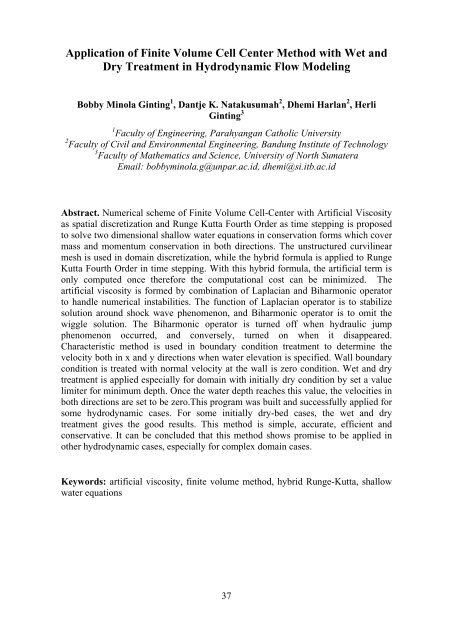Untitled - Teknik Kelautan / ITB
Untitled - Teknik Kelautan / ITB
Untitled - Teknik Kelautan / ITB
You also want an ePaper? Increase the reach of your titles
YUMPU automatically turns print PDFs into web optimized ePapers that Google loves.
Application of Finite Volume Cell Center Method with Wet and<br />
Dry Treatment in Hydrodynamic Flow Modeling<br />
Bobby Minola Ginting 1 , Dantje K. Natakusumah 2 , Dhemi Harlan 2 , Herli<br />
Ginting 3<br />
1 Faculty of Engineering, Parahyangan Catholic University<br />
2 Faculty of Civil and Environmental Engineering, Bandung Institute of Technology<br />
3 Faculty of Mathematics and Science, University of North Sumatera<br />
Email: bobbyminola.g@unpar.ac.id, dhemi@si.itb.ac.id<br />
Abstract. Numerical scheme of Finite Volume Cell-Center with Artificial Viscosity<br />
as spatial discretization and Runge Kutta Fourth Order as time stepping is proposed<br />
to solve two dimensional shallow water equations in conservation forms which cover<br />
mass and momentum conservation in both directions. The unstructured curvilinear<br />
mesh is used in domain discretization, while the hybrid formula is applied to Runge<br />
Kutta Fourth Order in time stepping. With this hybrid formula, the artificial term is<br />
only computed once therefore the computational cost can be minimized. The<br />
artificial viscosity is formed by combination of Laplacian and Biharmonic operator<br />
to handle numerical instabilities. The function of Laplacian operator is to stabilize<br />
solution around shock wave phenomenon, and Biharmonic operator is to omit the<br />
wiggle solution. The Biharmonic operator is turned off when hydraulic jump<br />
phenomenon occurred, and conversely, turned on when it disappeared.<br />
Characteristic method is used in boundary condition treatment to determine the<br />
velocity both in x and y directions when water elevation is specified. Wall boundary<br />
condition is treated with normal velocity at the wall is zero condition. Wet and dry<br />
treatment is applied especially for domain with initially dry condition by set a value<br />
limiter for minimum depth. Once the water depth reaches this value, the velocities in<br />
both directions are set to be zero.This program was built and successfully applied for<br />
some hydrodynamic cases. For some initially dry-bed cases, the wet and dry<br />
treatment gives the good results. This method is simple, accurate, efficient and<br />
conservative. It can be concluded that this method shows promise to be applied in<br />
other hydrodynamic cases, especially for complex domain cases.<br />
Keywords: artificial viscosity, finite volume method, hybrid Runge-Kutta, shallow<br />
water equations<br />
37


